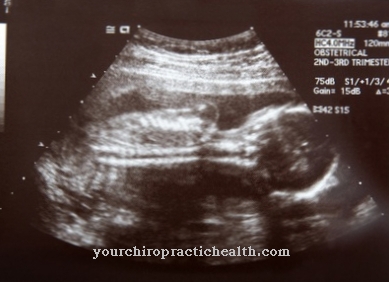Under the excretion the doctor understands the release of certain metabolic products into the environment. Without excretion, the equilibrium in the metabolism would be disturbed and poisoning by metabolic products such as ammonia could occur. Disturbed excretion occurs, for example, in the group of storage diseases.
What is the excretion?

Excretion is the elimination of undesirable or unusable metabolic products. Defecation as well as the excretion of dissolved components and the release of gaseous components fall under the term of excretion. During defecation, indigestible food components are excreted and dissolved components leave the body through urine through micturition. The products of these two excretion variants are collectively referred to as excrement. Gases and respiratory gases given off rectally by flatulence can also count towards excretion.
Six different excretion pathways are available in the human organism: the lungs, the skin, the kidneys, the liver, the large intestine and the mammary gland. In the narrower sense, however, only defecation and flatulence are included in the excretion.
Excretion takes place not only in the human and animal organism, but also in the plant organism. As a rule, this excretion takes place via special routes and refers to the excretion of all substances that are harmful to the plant organism.
Function & task
During excretion, by and large, all metabolic products that disturb the metabolic balance are excreted. With this aim, all nitrogen-containing metabolic products must be eliminated from the human organism. For humans, excreta are therefore primarily solid, liquid or gaseous products that contain nitrogen and could unbalance the metabolism.
In the amino acid metabolism and in the nucleic acid metabolism, ammonia is the most important waste product. In most animals, this ammonia is first converted into urea or uric acid, because in its original form the substance would be toxic to the organism. This is especially true of living creatures on the land. Because uric acid is difficult to dissolve in water, it is excreted as a crystalline substance or as a pasty substance with the excrement. Unlike uric acid, urea is water-soluble and is the most important excretion product of vertebrates. When urea is enriched, the osmotic pressure in the organism increases. Therefore, larger amounts of urea must first be dissolved in water.
Most terrestrial vertebrates are able to concentrate their urine. Urea is produced in your liver as part of the urea cycle, in which, as a starting material, carbon dioxide plays an important role as a starting material. From the liver, the urea reaches the kidneys and from there it travels to the bladder and leaves the body. In addition to ammonia, ammonium and creatinine are also substances of excretion and are mainly given off by humans in the urine.
Accompanying substances in excretion are usually water and lubricants, which migrate into the excreta, especially during the intestinal passage. In addition to nitrogen excretion, the excretion of salts is also important for the human body. To regulate the osmosis, the organism has to operate selective salt excretion and thus adjust the salt concentration. This selective excretion takes place mainly in the urine. In smaller quantities, the excretion of salts also takes place through sweat. In this way, the body prevents the concentration of dissolved substances from becoming too high and produces a tolerable water content.
In this way, excretion serves many purposes for humans. Detoxification, osmoregulation and control of the acid-base balance are among the most important, but excretion in the sense of sweating is also involved in thermoregulation.
Illnesses & ailments
Every path of excretion can be affected by diseases. A functional disorder can be present in the sweat glands, for example, and thus lead to hyperhidrosis, hypohidrosis, anhidrosis, bromhidrosis or chromhidrosis.
Hyperhidrosis is the excessive activity of the sweat glands, which can be chronic or acute. Brain diseases often cause such overactivity. Especially if the excessive sweating is predominantly local, innervation damage to certain glands is a possible cause.
The opposite phenomenon occurs in anhidrosis. The production of sweat is therefore greatly reduced in anhidrosis. This type of complaint is usually symptomatic and therefore occurs in the context of a certain primary disease, such as accompanying tuberculosis.
In bromhidrosis, the sweat takes on an abnormally strong odor and in chromhidrosis it changes color. Both phenomena usually refer to primary diseases, such as syphilis.
Excretion diseases can also appear as storage diseases, for example in the context of Wilson's disease. With this disease, the body stores copper substances in the organs and thus damages the liver up to cirrhosis. The group of lysosomal storage diseases also results in impaired excretion and is usually associated with enzymatic defects.
An excess of uric acid, on the other hand, occurs in gout, for example. All kidney, liver and intestinal diseases can just as well lead to excretion problems. In the same way, a symptomatic excretion disorder often occurs in diseases of the nervous system, which is caused by nervous system malregulation.
























.jpg)



